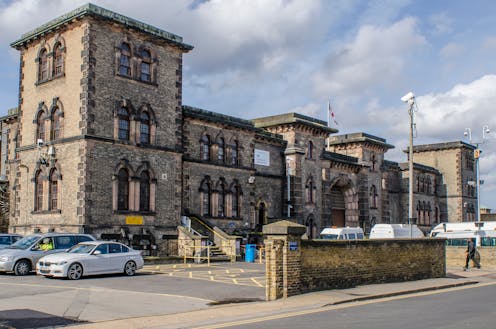
Following the recapture of escaped terror suspect Daniel Khalife, there will no doubt be an inquiry into the prison system and how an inmate managed to apparently strap himself to a van and be driven out under the noses of prison security. But whether another inquiry prompted by a prison escape will actually focus on the very many problems besetting the UK’s prison system is another matter altogether.
This is the first time I’ve seen this much attention paid to prisons since I published my book on the failure of Britain’s prisons a decade ago. As a former governor of HMP Belmarsh and Brixton, as well as a former prisons inspector, I am intimately familiar with the reality behind the intrigue of a prison escape.
The current structure of the English and Welsh prison service is predicated on escapes. The 1960s saw several high-profile prison escapes, most notably the Great Train Robbers, Charlie Wilson (from HMP Winson Green, Birmingham) and Ronnie Biggs (also from HMP Wandsworth). This was followed by the even more audacious escape of spy George Blake from Wormwood Scrubs in October 1966.
The resultant furore triggered an inquiry and subsequent report by Lord Mountbatten. A key outcome was the creation of the prison categorisation system, A,B,C,D, which is still in place today.
The highest security prisons are Category A, and the lowest are Category D – “open” prisons, with minimal security. In the latter, prisoners who have been risk-assessed are allowed to spend most of their day away from the prison for work or education. Most prisoners are located in a Category C, which are training and resettlement prisons. Prisoners will have a relatively short time left to serve and security is only a 5m fence.
HMP Wandsworth, where Khalife escaped from, is a Category B – less secure than a Category A, these are either local or training prisons. The former hold prisoners from the local area (sentenced or on remand), while the latter hold long-term and some high-security prisoners.
Sixty years later, this system still determines how prisons are run and funded. The average annual overall cost of a prison place in England and Wales is now £48,162. The cost in a high-security prison can be double this, and half as much in an open prison.
Ease of escape
From the 1960s – and for the rest of the century – escapes dominated the prison psyche. In those days you could run and hide, you could just about get by, and if sufficiently equipped, make it to the “Costa Del Crime”, where the lack of an extradition treaty between the UK and Spain from 1978 until 1985 made it a desirable destination for criminals.
While escapes over secure Victorian prison walls get all the attention, it has always been easier to get out between prisons – on the way to courts and hospitals, where the only “perimeter” is a hapless individual or two on low pay in a glorified transit van.
It would also have been simplicity itself for a gang to break in and get you out. But while the movies enthusiastically embraced such scenarios, serious organised criminals and terrorists baulked at the challenge, given the resources required and the high levels of surveillance in the modern world. The last such escape was by helicopter from HMP Gartree in 1987.
Escape rates have fallen over the years. A major turning point was the escape of six prisoners from a special security unit at Whitemoor Prison in Cambridge on September 1994. The escape led to the Woodcock inquiry, which recommended an overhaul of security mechanisms and procedures that effectively introduced the “maximum-security” of today.
Unfortunately, the success of prisons is still largely measured primarily on two things, escapes and riots. Both are now rare, not because of the success of politicians, but because the world has changed.
If you escape today, there is nowhere to hide in a world of high surveillance and communications. George Blake got to Moscow, Daniel Khalife only made it as far as Chiswick. Many escapees simply go home. A few organised criminals sprung from prison vans are caught at their next crime scene.

Crime within prison
The current chief inspector of prisons, Charlie Taylor, and his predecessors over the past two decades have told us all we need to know about deteriorating prison conditions, including at Wandsworth. Overcrowding and high staff turnover are two of many chronic problems that likely contributed to the lax security Khalife took advantage of.
But this rare escape is overshadowing other security breaches that we don’t talk about.
Prisoners, even those who do not escape, are resourceful. Some will spend their time gaining qualifications, skills and training, although such opportunities are declining, largely due to lack of funding.
Others can make money smuggling drugs and mobile phones in an environment where the prices are inflated, the demand insatiable and the business lucrative. A recent inspection of HMP Woodhill – a purpose built, hi-tech Category A jail Mountbatten would be proud of – revealed 38% of prisoners were testing positive for drugs (a gross underestimation in my experience).
Serous organised crime is seriously well-organised in prison, helped by demoralised, poorly trained, poorly paid and poorly led staff who are easy prey to manipulation, intimidation and threats.
It would be nice to think that Khalife’s escape is trigger for society to wake up to the dire circumstances in Britain’s failing prison system. This brief media frenzy comes after two decades of malaise, where politicians can’t think beyond “getting tough” on crime. But it is further proof of what I and many others have argued for years: Britian’s prisons, in their current form, do not work.
John Podmore does not work for, consult, own shares in or receive funding from any company or organization that would benefit from this article, and has disclosed no relevant affiliations beyond their academic appointment.
This article was originally published on The Conversation. Read the original article.







